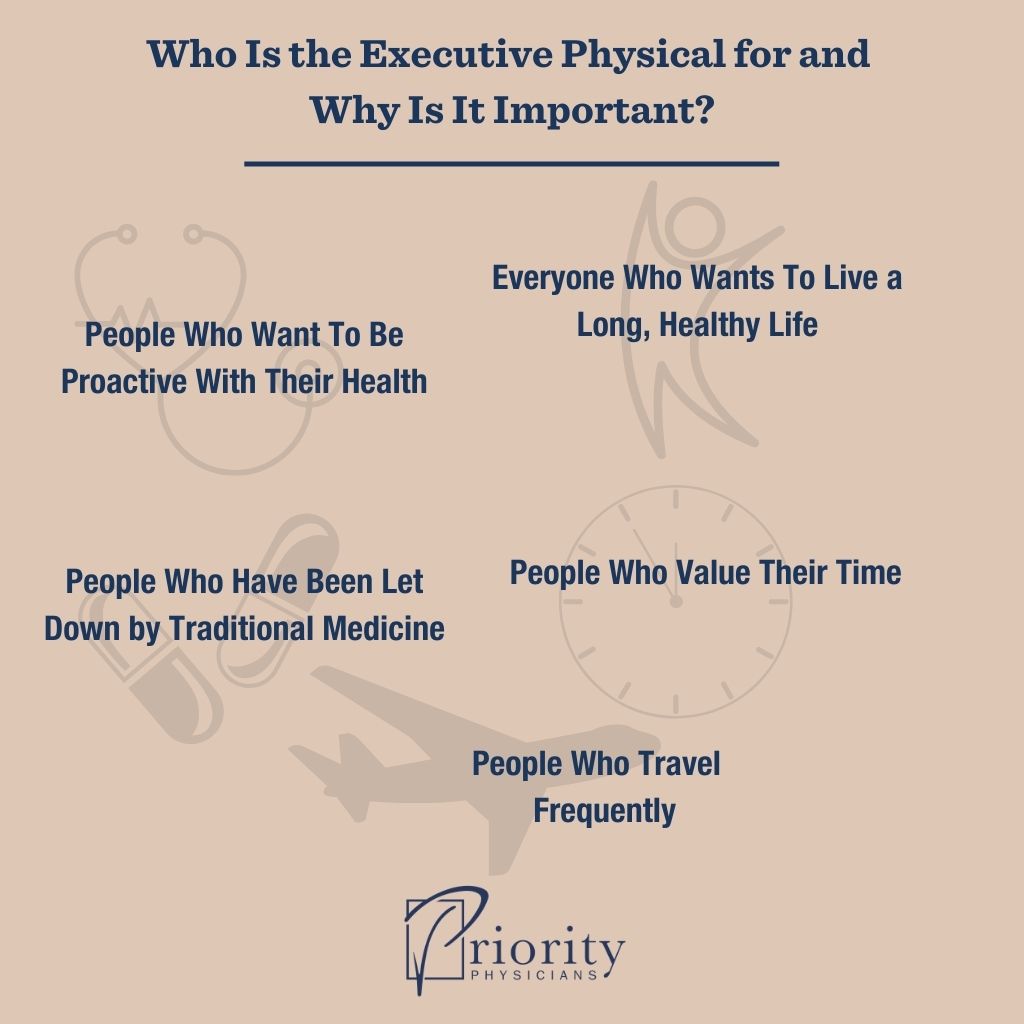Have you ever been in a doctor’s office and the entire time, the doctor was looking at your chart instead of you?
It’s not a good feeling.
Or maybe you’ve had an annual physical where the doctor perfunctorily checked your heart and lungs, then was halfway out the door before you could ask questions.
You probably left wondering why you went in the first place.
It’s no wonder many people have a bad taste in their mouths when it comes to getting a physical. But this is where an executive physical can change your mind.
What Is an Executive Physical?
An executive physical is an in-depth physical in which your doctor spends 3–4 hours talking with you about your health history. It’s unpacking everything that usually gets glossed over in traditional, 15-minute physical at an insurance-based practice.
Below are some areas an executive physical covers.
Prevention
Prevention isn’t usually covered by insurance companies, so it’s often missed in a traditional practice. This is a real disservice to patients, as being proactive through simple testing and diagnostics can avert much bigger health issues down the road.
We include quite a few diagnostic tests and screening tools in our executive physicals:
- Heart scans.
- Coronary CT angiograms.
- Stress tests.
- Mole mapping.
- Body composition.
- Lab tests.
Even the tests we run that are similar to tests in a typical physical are much more in-depth or use much more advanced technology than what you’d usually experience. We’re serious about getting the whole picture on your health and using that to prevent disease from interfering with your life.
Labs
If you’ve ever had lab work with a traditional primary care doctor, you probably received very little explanation about the results. Maybe they told you your cholesterol was high, or your blood sugar was in the pre-diabetic range. Or maybe they simply posted the results in your patient portal with a note.
That’s not how we do it.
As part of the executive physical, we set aside significant time to go over your lab results with you, which are color-coded in red, yellow, and green. We believe that when you understand your lab numbers, you better understand what’s going on in your body. This in turn empowers you to improve your health (and lab numbers) through lifestyle changes.
Follow-Up Care Coordination
Sometimes an executive physical may reveal an issue that requires a specialist’s attention. A patient might need a colonoscopy or a mammogram, or they might simply need follow-up labs in three months.
It can be a lot to coordinate and manage.
After your executive physical, we don’t drop out of the picture and leave the next tasks solely with you. Rather, we take care of scheduling specialist appointments and any further testing. We believe it’s our job to continue being your advocate and navigating the ins and outs of your follow-up care.
How Is an Executive Physical Different From a Traditional Annual Exam?
The biggest difference between an executive physical and an annual exam at a traditional practice is twofold.
First, an executive physical adapts to you, not the other way around.
In an executive physical, your physician meets you where you are to determine your current level of health and your health goals. They help you identify problems through testing, yes, but also through conversations with you.
For example, in a traditional physical, a doctor might weigh a patient and then focus on weight loss for the rest of the exam. In an executive physical, if we find a patient is overweight, we look a little deeper to find out why. Maybe they have an undiagnosed thyroid problem, or a mental health issue. Maybe they can’t exercise due to back pain. Or maybe they just need a physician’s support and advice. Whatever the reason, we never just blame the patient and move on.
We also aim to identify and find solutions for the problems you’re most concerned about, not just those your doctor considers important. Maybe a test identifies an issue with cholesterol in your blood work, but you’ve been struggling with lower-back pain that affects your ability to work and play. One isn’t overlooked for the other. The goal is to work together to find solutions for both of these issues.
Second, insurance doesn’t cover many of the diagnostic and screening tools we use in executive physicals. This means most of these tests aren’t included or even offered in traditional annual exams, even though they can be extremely helpful.
Because direct primary care (DPC) physicians don’t take insurance, we can provide specialized, personalized care that isn’t dictated by insurance coverage. We have both the time and the freedom to take a whole-body approach, getting to know you, your health history, and your lifestyle to achieve the best health outcomes for your life.
Who Is the Executive Physical for and Why Is It Important?
Everyone Who Wants To Live a Long, Healthy Life
We don’t mean to sound dramatic, but really, anyone who wants to live a long, healthy life should be interested in an executive physical.
Too often we see patients who appear perfectly healthy, but then discover they have a serious underlying health issue. We’ve had 40-year-olds with heart disease. A 50-year-old who ran daily but needed urgent, life-saving cardiac bypass surgery — which we discovered in the executive physical.
The point is, you don’t know unless you look. An executive physical is an in-depth way to look at your health and make sure nothing is threatening the life you want to live.
People Who Want To Be Proactive With Their Health
Executive physicals really serve people who want to take proactive action with their health. For example, if you know you have a family history of a serious health condition — heart disease, cancer, stroke, diabetes — an executive physical can help you identify early warning signs and take proactive action to mitigate or avoid that condition in the future.
Conversely, if you’re not interested in making any changes regardless of your test results or doctor’s advice, an executive physical can’t do you much good.
People Who Value Their Time
Spending two hours in a waiting room just to see a doctor for 20 minutes doesn’t feel especially efficient. Your time is worth more than that. An executive physical makes the most of your time by condensing a high-value, no-wait physical that collects all your vital health information into one day of the year.
People Who Travel Frequently
If you travel often or are based in another city or state than your doctor, an executive physical is especially valuable. Your physician gets to know you thoroughly in a single, in-person visit, and can then treat you much more effectively from a distance whether you’re at home or abroad.
People Who Have Been Let Down by Traditional Medicine
If you are someone who has been misdiagnosed or who struggled to find a diagnosis for an unusual health condition, you likely feel let down by the traditional healthcare system. In such scenarios, patients often bounce from doctor to doctor, looking for someone to examine the whole picture.
The executive physical collects your in-depth medical information all in one place and provides you with a doctor who’s committed to consciously thinking about you — a quarterback for your healthcare.
Who Offers Executive Physicals and Who Conducts Them?
DPC and concierge medical practices that aren’t ruled by insurance companies offer executive physicals. With low doctor-patient ratios and a lack of interference from insurance companies, we have the time and freedom to provide this kind of high-impact, personalized care.
At Priority Physicians, our doctors are the ones conducting the executive physicals, from taking your blood pressure to conducting a stress test.
Some practices use physician assistants, nurse practitioners, and nurses in order to save the doctor’s time, and we understand why. But we feel those hours spent with the patient, even performing simple tasks, allow the doctor and patient the chance to get to know each other well and give the patient room to ask questions that come up throughout the process.
Next Steps
If you want to take serious, proactive steps for your health, an executive physical is for you. Contact Priority Physicians today to get started.


